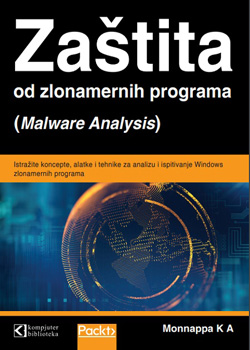
Autor: Vijay Kumar Velu, Robert Beggs
Broj strana: 548
ISBN broj: 9781789340563
Izdavač:
PACKT PUBLISHING ![]()
Godina izdanja: 2019.
 |
 |
 |
 |
 |
||||
This book takes you, as a tester or security practitioner, through the reconnaissance, vulnerability assessment, exploitation, privilege escalation, and post-exploitation activities used by pentesters. To start with, you'll use a laboratory environment to validate tools and techniques, along with an application that supports a collaborative approach for pentesting. You'll then progress to passive reconnaissance with open source intelligence and active reconnaissance of the external and internal infrastructure. You'll also focus on how to select, use, customize, and interpret the results from different vulnerability scanners, followed by examining specific routes to the target, which include bypassing physical security and the exfiltration of data using a variety of techniques. You'll discover concepts such as social engineering, attacking wireless networks, web services, and embedded devices. Once you are confident with these topics, you'll learn the practical aspects of attacking user client systems by backdooring with fileless techniques, followed by focusing on the most vulnerable part of the network – directly attacking the end user. By the end of this book, you'll have explored approaches for carrying out advanced pentesting in tightly secured environments, understood pentesting and hacking techniques employed on embedded peripheral devices.
Table of contents
1 Goal-Based Penetration Testing
Conceptual overview of security testing
Misconceptions of vulnerability scanning, penetration testing, and red team exercises
Objective-based penetration testing
The testing methodology
Introduction to Kali Linux – features
Installing and updating Kali Linux
Organizing Kali Linux
Building a verification lab
Managing collaborative penetration testing using Faraday
Summary
2 Open Source Intelligence and Passive Reconnaissance
Basic principles of reconnaissance
Google Hacking Database
Creating custom wordlists for cracking passwords
Summary
3 Active Reconnaissance of External and Internal Networks
Stealth scanning strategies
DNS reconnaissance and route mapping
Employing comprehensive reconnaissance applications
Identifying the external network infrastructure
Mapping beyond the firewall
IDS/IPS identification
Enumerating hosts
Port, operating system, and service discovery
Writing your own port scanner using netcat
Large-scale scanning
Summary
4 Vulnerability Assessment
Vulnerability nomenclature
Local and online vulnerability databases
Vulnerability scanning with Nmap
Web application vulnerability scanners
Vulnerability scanners for mobile applications
The OpenVAS network vulnerability scanner
Commercial vulnerability scanners
Specialized scanners
Threat modeling
Summary
5 Advanced Social Engineering and Physical Security
Methodology and attack methods
Physical attacks at the console
Creating a rogue physical device
The Social Engineering Toolkit (SET)
Hiding executables and obfuscating the attacker's URL
Escalating an attack using DNS redirection
Launching a phishing attack
Using bulk transfer as a mode of phishing
Summary
6 Wireless Attacks
Configuring Kali for wireless attacks
Wireless reconnaissance
Bypassing a hidden SSID
Bypassing the MAC address authentication and open authentication
Attacking WPA and WPA2
Denial-of-service (DoS) attacks against wireless communications
Compromising enterprise implementations of WPA/WPA2
Working with Ghost Phisher
Summary
7 Exploiting Web-Based Applications
Web application hacking methodology
The hacker's mind map
Reconnaissance of web apps
Client-side proxies
Application-specific attacks
Summary
8 Client-Side Exploitation
Backdooring executable files
Attacking a system using hostile scripts
The Cross-Site Scripting framework
The Browser Exploitation Framework (BeEF)
Understanding BeEF Browser
Summary
9 Bypassing Security Controls
Bypassing Network Access Control (NAC)
Bypassing the antivirus with files
Going fileless and evading antivirus
Bypassing application-level controls
Bypassing Windows operating system controls
Summary
10 Exploitation
The Metasploit Framework
Exploiting targets using MSF
Exploiting multiple targets using MSF resource files
Exploiting multiple targets with Armitage
Using public exploits
Developing a Windows exploit
Summary
11 Action on the Objective and Lateral Movement
Activities on the compromised local system
Horizontal escalation and lateral movement
Summary
12 Privilege Escalation
Overview of the common escalation methodology
Escalating from domain user to system administrator
Local system escalation
Escalating from administrator to system
Credential harvesting and escalation attacks
Escalating access rights in Active Directory
Compromising Kerberos – the golden-ticket attack
Summary
13 Command and Control
Persistence
Using persistent agents
Domain fronting
Exfiltration of data
Hiding evidence of an attack
Summary
14 Embedded Devices and RFID Hacking
Embedded systems and hardware architecture
Firmware unpacking and updating
Introduction to RouterSploit Framework
UART
Cloning RFID using Chameleon Mini
Summary
• Aleksandar Škiljević
Da li je realno da se nadamo prevodu ove knjige?

Popust cena:
2100.00 rsd

Popust cena:
2200.00 rsd
© Sva prava pridržana, Kompjuter biblioteka, Beograd, Obalskih radnika 4a, Telefon: +381 11 252 0 272 |
||